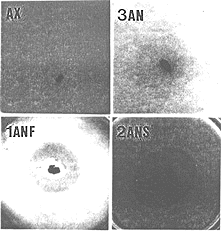In an ex vivo agar plate assay, we monitored the appearance of an inhibitory halo against Vibrio cholerae from the feces of Wistar and Fischer rats aged 10 to 42 days. The frequency of Wistar rats showing halo increased from 0% (10 days) to a maximum of 80.0% (29 days) and then decreased to 53.3% (42 days). A similar pattern was obtained with Fischer rats but with a lower intensity (maximum frequency of 50.0% by day 36). In a separate experiment, when Wistar rats were fed a low-protein diet for 7 days, the inhibitory halo decreased drastically. Three apparently different colony morphologies were isolated from the dominant fecal microbiota: a facultative anaerobe (FAN) and two strict anaerobes (SAN). The ex vivo inhibitory test showed a halo around the feces of germfree mice monoassociated with the FAN bacterium or one of the SAN bacterium but not of the germfree ones. After oral challenge of all groups with V. cholerae, a permissive and a drastic barrier effects were observed in mice with FAN and SAN associated bacteria, respectively. The FAN and one SAN bacteria used in the in vivo challenges were identified as Escherichia coli and Streptococcus intermedius, respectively. The potent antagonism developed by the rat intestinal microbiota against V. cholerae seems to be due, in part, to diffusible compounds and this phenomenon depends apparently on age, strain and nutrition of the animals. These preliminary results also suggest that this effect was due to more than one bacterial component at any given moment.
Vibrio cholerae; Escherichia coli; Streptococcus intermedius; antagonism; rodents








